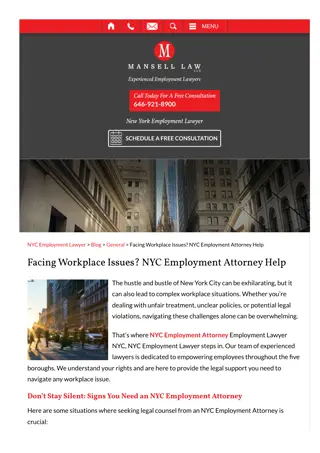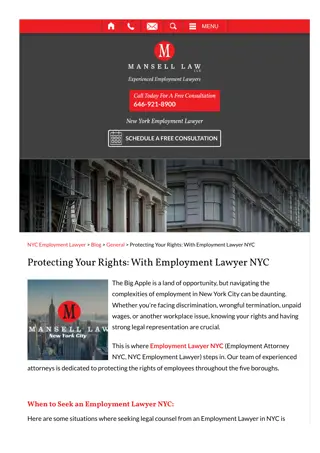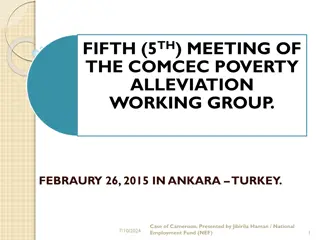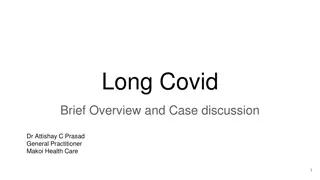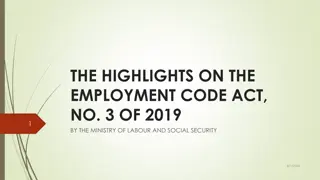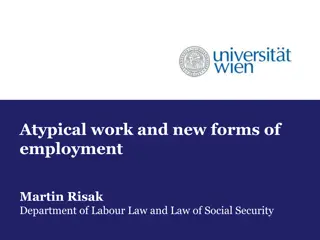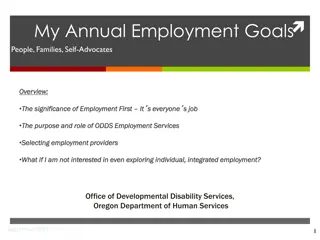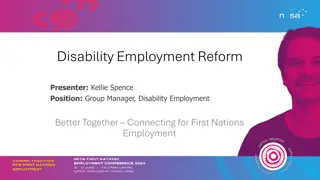Impact of COVID-19 on Employment Law
This presentation highlights the impact of COVID-19 on Employment Law, covering changes in regulations, key legal considerations, and available assistance for employers and employees. It emphasizes the rapidly evolving nature of government responses and the need for diligence in navigating employment issues during this period.
Download Presentation

Please find below an Image/Link to download the presentation.
The content on the website is provided AS IS for your information and personal use only. It may not be sold, licensed, or shared on other websites without obtaining consent from the author. Download presentation by click this link. If you encounter any issues during the download, it is possible that the publisher has removed the file from their server.
E N D
Presentation Transcript
How COVID-19 has affected Employment Law Presented by Scott Chambers, B.A., J.D., CPHR March 31, 2020 www.doakshirreff.com
COVID-19 & Employment Law This presentation is for free informational purposes only and does not constitute legal advice or create a retainer between you and Doak Shirreff Lawyers LLP. Any views or opinions expressed are the presenter s own. This presentation applies only to Employment and Human Resources Law, not Labour Law (Union environments). www.doakshirreff.com
COVID-19 & Employment Law PLEASE NOTE The provincial and federal government response to the COVID-19 pandemic changes rapidly and daily. As such, the information provided today is as up to date as possible but may change as new programs or amendments to the various legislations occurs. Conduct due diligence on all information prior to making any decisions or speak to a lawyer if you have specific questions regarding your employment or employee s rights and obligations during this period. www.doakshirreff.com
COVID-19 & Employment Law Technical Details: All attendees are muted and not visible through their webcams to others in the webinar. Questions: Please type any questions that you may have in the zoom chat feature and Doak Shirreff employment lawyers, Jonathan Arkle and Nikita Gush, will be answering questions live. www.doakshirreff.com
The Outline for Todays Webinar Part A - The Basics of Employment Law The Basics of Employment Agreements; How the Employment Standards Act deals with Lay Offs; How the Employment Standards Act deals with Termination; How the Courts deal with Termination beyond the Employment Standards Act; 1. 2. 3. 4. Part B - COVID-19 Changes to the BC Employment Standards Act How Lay Offs normally operate under the ESA; New Protected Leaves under the ESA; 1. 2. Part C - COVID-19 Changes to the Employment Insurance Act & New Benefits Available 1. Changes to the federal Employment Insurance Act; 2. New federal Benefits Programs available as a result of COVID-19; Part D Federal Assistance Available to Employers & Small Businesses Existing programs to assist Employers to avoid layoffs; Small Business Wage Subsidies; Business Credit Availability Program. 1. 2. 3. www.doakshirreff.com
The Basics of Employment Law Surprisingly, very few employees have written Employment Agreements. If they do, they are often not legally enforceable. There is no legal requirement for a written Employment Agreement, but it is highly recommended to reduce risk and financial liability to employers during termination. Employment Agreements generally protect the Employer, not the Employee. The Employee is protected by the Employment Standards Act and the common law. www.doakshirreff.com
The Basics of Employment Law A written Employment Agreement outlines the basic terms of the employment relationship, including: A brief job description including roles and responsibilities; The duration or term of the employment (if applicable); Compensation; Benefits provided including health, dental, vacations, etc.; and MOST IMPORTANTLY - Termination and resignation clauses; AND, perhaps now, Lay Off clauses for unforeseen events, like pandemics (which will be discussed in greater detail later). An Employer cannot contract out of applicable Employment legislation. For the Employment Agreement to be valid and binding, it must comply with the Employment Standards Act and any other applicable legislation, including the Human Rights Code and Occupational Health and Safety Regulations. www.doakshirreff.com
The Basics of Employment Law Every Employment Agreement should, at a minimum, include a legally enforceable termination clause. The termination clause should explain the different legal obligations in the event of termination for cause or termination without cause. If an employee is terminated for cause, then no notice is required under the Employment Standards Act or at common law. Cause is not necessarily a defined term, but includes job abandonment, gross insubordination, theft from the employer, workplace violence and intoxication from drugs or alcohol at work. Performance issues are rarely just cause for termination. If an employee is terminated without cause, then they are entitled to the minimum notice requirements under the Employment Standards Act and additional severance or termination pay entitlements under the common law unless they have an Employment Agreement limiting the amounts payable on termination. The common law is the court decisions determining notice requirements on termination beyond the Employment Standards Act. www.doakshirreff.com
The Basics of Employment Law Without Cause Termination Notice Requirements under the Employment Standards Act (ESA) Length of Consecutive Service Notice Required under ESA Zero to 3 months no notice required 3 months to 1 year 1 week 1 2 years 2 weeks 3 4 years 3 weeks 4 5 years 4 weeks 5 6 years 5 weeks 6 7 years 6 weeks 7 8 years 7 weeks 8 or more years 8 weeks www.doakshirreff.com
The Basics of Employment Law If there is no Employment Agreement, the employee may be entitled to ESA minimums and reasonable notice under common law. The courts determine what "reasonable notice" is on a case-by-case basis using the Bardal Factors. These factors include the employee's age, length of service, type of employment (managerial v. non-managerial) and availability of similar employment taking into account the employee s particular skillset. The rule of thumb for reasonable notice is approximately 1 month per year of service but this varies on a case-by-case basis. Remember, this is additional to Employment Standards Act requirements. www.doakshirreff.com
The Basics of Employment Law While traditionally, the Bardal Factors have resulted ina maximum reasonable notice period of 24 months, this is no longer the rule . Reasonable notice has been increased to 30+ months for some employees, including those approaching retirement or with a specific skill-set that makes re-employment without new training / education impossible or when the termination is essentially a forced retirement. www.doakshirreff.com
The Basics of Employment Law Additionally, while not currently a legal requirement under the Employment Standards Act in BC, benefits should continue throughout the ESA notice period. The courts in other provinces, including Ontario, have held that all extended benefits that form part of the compensation package on the date of termination should be extended throughout the ENTIRE notice period. This is not the law currently in BC, but it could be soon. www.doakshirreff.com
Layoffs & The Employment Standards Act HOW THE LAW CURRENLY & TECHNICALLY STANDS: Temporary Layoff v. Week of Layoff Under the ESA, an employer can temporarily layoff an employee for 13 weeks in a 20-week period. OR If an employee is not going into a temporary layoff, a week of layoff occurs when an employee s hour/renumeration is reduced by 50% in any given week for an indefinite period of time. www.doakshirreff.com
Layoffs & The Employment Standards Act HOW THE LAW CURRENLY & TECHNICALLY STANDS: In both cases, unless an employee is in an industry where temporary layoffs or week of layoff are commonplace (i.e. forestry, teaching, etc.), or the employment agreement explicitly provides for temporary layoffs or week of layoffs, the employee MUSTconsent to the temporary layoff or week of layoff. If the employee does not consent, then the temporary lay off or the week of lay off is a constructive dismissal and the employee would be owed Employment Standards Act notice payments (essentially 1 week per year to a 8 week maximum) and/or additional reasonable notice under the common law (1-5 weeks of notice in addition to the ESA). www.doakshirreff.com
Layoffs & The Employment Standards Act HOW THE LAW IS CURRENTLY OPERATING Employers are not getting the required consent to temporarily lay-off employees. This will likely be permissible (suspension of common law requirements) in a time of extremes such as COVID-19, but only time will tell. Realistically, in my opinion, employees will be deemed irresponsible for not agreeing to a temporary layoff in this pandemic, will be deemed to have failed to mitigate their damages, and would likely be disentitled from enhanced notice pay if they pursued it post-pandemic. However, temporary layoffs without consent are a calculated risk. See my article: https://www.doakshirreff.com/employer-covid-19/covid-19-the-legality-of- temporary-lay-offs/ www.doakshirreff.com
Changes to the BC Employment Standards Act due to COVID-19 Pandemic In response to the COVID-19 pandemic, the BC government made some very basic changes to the Employment Standards Act as related ONLY to protected unpaid leaves of absence. There are no changes to the ESA for temporary layoffs, reduction of hours, overtime pay or notice on termination requirements. www.doakshirreff.com
Changes to the BC Employment Standards Act due to COVID-19 Pandemic The Employment Standards Act has always provided for a number of job- protected unpaid leaves of absence (from 3 days to 105 weeks). This means that if an employee is within one the listed categories, they are entitled to take an unpaid leave of absence from work and their position would be protected and available to them upon their eventual return to work. Surprisingly however, the previously protected leaves under the ESA did not include a leave if the employee themself was ill or critically injured. All the previously protected leaves pertained exclusively for care-givers of sick or critically ill family members, bereavement leaves, leaves for victims of domestic & sexual violence, maternity leaves, jury duty, or leaves if a child was killed or missing, etc. www.doakshirreff.com
Changes to the BC Employment Standards Act due to COVID-19 Pandemic The recently announced changes to the Employment Standards Act now include a protected leave for employees who are ill or injured (not necessarily COVID- 19 related) provided that they have worked for their employer for at least 90 days. This leave is for 3 days only. This leave will likely remain in the Employment Standards Act post-pandemic. www.doakshirreff.com
Changes to the BC Employment Standards Act due to COVID-19 Pandemic Another newly introduced change to the Employment Standards Act are COVID-19 specific unpaid leaves for employees unable to work for reasons directly related to the pandemic, including: 1. Employees who are ill with the virus (required/mandated self- quarantine or hospitalization); Employees who need to self-isolate / self-quarantine (either due to travel related quarantines, increased risk on exposure or recommended self-quarantine due to symptoms); Employees who need to care for a child (who is not sick but when the employee cannot work due to school or day care closures and childcare needs); and/or Employees told by their employers to self-isolate/self-quarantine due to exposure risks to others in the workplace. 2. 3. 4. www.doakshirreff.com
Changes to the BC Employment Standards Act due to COVID-19 Pandemic There is no time limit on the length of the Employment Standards Act protected leaves for COVID-19 related issues as long as the employee is unable to work due to one of the COVID-19 related reasons, they currently remain eligible for this leave indefinitely. Employees cannot be denied these protected leaves, nor can they be terminated or otherwise penalized, for taking these leaves. The criteria for these COVID-19 protected leaves are: Positive diagnosis of COVID 19 virus and required hospitalization or self- quarantine; Self-isolation/or quarantine pursuant to provincial order or BC Centre for Disease Control guidelines, etc.; Providing care to dependent (family member or other); Cannot return due to border restrictions or due to travel self-isolation requirements; or When directed not to come to work from employer. 1. 2. 3. 4. 5. www.doakshirreff.com
Changes to the BC Employment Standards Act due to COVID-19 Pandemic These specific COVID-19 protected leaves will likely only be temporary amendments to the Employment Standards Act and will be removed post-pandemic.The only change that will likely remain in the Employment Standards Act post-pandemic will be the personal sick leave of 3 days, but this may be amended further to require a medical certificate or doctors note going forward. Employees taking any leave from work would be issued a Record of Employment for the interruption to income (if more than 5 days) and then advised to apply, if eligible, for the existing or amended federal Employment Insurance benefits or newly introduced benefits for those who are ineligible for Employment Insurance benefits. If the employer believes that the employee is no longer meeting the leave requirements, they are permitted to request reasonably sufficient proof that the employee remains eligible. Medical documentation should be only sought in the clearest cases and should only done so with caution. www.doakshirreff.com
Changes to the Federal Employment Insurance Act As before, if an employee is temporarily laid off or terminated from their position, they can apply for Employment Insurance benefits for a maximum of 45 weeks at 55% of the employee s annual insurable income (up to $52,200) earned in the last 52 weeks to a maximum benefit of $573/week. There is a 1 week waiting period for these EI benefits. An employee will need a Record of Employment with a reason code to permit EI benefits (i.e. temporary lay off, dismissal without cause). Normally quitting a job is not a valid reason for employment insurance benefits. www.doakshirreff.com
Changes to the Federal Employment Insurance Act The existing Employment Insurance Act also provides for Employment Insurance Sickness Benefits for a period of 15 weeks at the same rate as regular EI benefits 55% of insurable income up to $52,200 to a maximum of $573/week. An employee would normally need a Record of Employment with a reason code for sickness, illness or disability, but this requirement has been temporarily waived with the recent changes to the Employment Insurance Act. www.doakshirreff.com
Changes to the Federal Employment Insurance Act The Federal Government made a number of changes to the Employment Insurance Act as well as introduced new legislation to assist employees effected by the pandemic, particularly those employees who would not otherwise qualify for benefits under the Employment Insurance Act for employment insurance benefits or EI sickness benefits. www.doakshirreff.com
Changes to the Federal Employment Insurance Act Regular Employment Insurance benefits and criteria remain unchanged for terminated or laid off employees. Changes to EI Sickness Benefits: Immediate coverage (there is no longer a 1 week waiting period for benefits) for up to 15 weeks; No Record of Employment or Medical Certificate/Doctors Note is required; Does not have to be a COVID-19 sickness www.doakshirreff.com
The New Federal Emergency Benefits Canada Emergency Response Benefit (CERB) This is an amalgamation of two previous benefit packages that were being assembled to respond to the pandemic (Emergency Care Benefit & Emergency Support Benefit). The combine benefit is to provide comprehensive COVID-19 coverage to those who would not otherwise be covered by Employment Insurance benefits, like the self-employed, people in quarantine (sick or mandatory due to potential exposure), and working parents affected by school/day-care closures. www.doakshirreff.com
The New Federal Employment Insurance Act & OtherBenefits Canada Emergency Response Benefit (CERB) These benefits are available for: 1. Workers who must stop working due to COVID-19 (illness or otherwise) and do not have access work paid leave or other income support; 2. Workers who are sick, quarantined or taking care of someone who is sick with the COVID-19 virus; 3. Working parents who must now stay home without pay to care for children that are sick or in need of care due to school / day-care closures; 4. Workers who still have employment but are not currently being paid because there is not sufficient work, or their employer has asked them not to come into work for any COVID-19 related reason (i.e. restaurant closures); and 5. Wage earners and self-employed individuals including contract workers, who would not otherwise be eligible for Employment Insurance benefits. www.doakshirreff.com
The New Federal Employment Insurance Act & OtherBenefits Canada Emergency Response Benefit (CERB) These benefits will be retroactive to March 8, 2020 but will not become available until mid-April 2020. The government is establishing an online application process through existing Service Canada and CRA portals. These benefits will be up to a maximum of $500/week ($2,000/month) for up to 4 months and a Record of Employment is not required. www.doakshirreff.com
Federal Assistance Available to Employers & Small Businesses Work Sharing The Employment Insurance Act provides for work-sharing programs in times of economic downturn. These programs essentially allow employers to have their employees work less hours to share a smaller pool of available work. Rather than laying off the employees, the program allows them to share the work and augment their income loss through employment insurance benefits. Work-sharing programs have to be applied for and employers need to demonstrate a downturn in revenues, that they have been in business for at least 2 years and have an economic recovery plan in place for the future. Further details of work-sharing programs can be found here: https://www.canada.ca/en/employment-social- development/services/work-sharing/eligibility.html www.doakshirreff.com
Federal Assistance Available to Employers & Small Businesses Small and Medium Business Wage Subsidies On March 30, 2020 the federal government announced details of its newly revised wage subsidy program. Qualifying businesses are eligible for a 75% wage subsidy for up to three months, retroactive to March 15, 2020 to allow businesses to keep and return workers to payroll, rather than resorting to layoffs. The prior wage subsidy program was only a 10% subsidy. Eligibility criteria will be announced in the upcoming days, but details to date are: 1. Employers need to show a 30% decrease in revenues as a result of the COVID-19 economic downturn; The wage subsidy will cover up to $847/week per employee on the employee s first $58,700 in annual income; Employers are encouraged to top up the 25% shortfall in employee income during this period; The business size is currently not a relevant factor for qualification; and This is a good faith program and there will be serious consequences for those who are found to have abused the program. 2. 3. 4. 5. www.doakshirreff.com
Federal Assistance Available to Employers & Small Businesses Business Credit Availability Program (BCAP) This is a $65 billion support program through the Business Development Bank of Canada (BDC) and Export Development Canada (EDC). This program includes: 1. Interest-free loans up to $40,000 to small businesses and non- profits to help cover operating costs when revenues have been temporarily reduced; To qualify, businesses need to demonstrate $50,000 - $1 million in total payroll in 2019. 2. Details of the EDC and BDC loans will be released within the next three weeks and employers are encouraged to speak to their current financial institutions for applications, criteria requirements and guidelines as the program details are released. www.doakshirreff.com
New Doak Shirreff Fixed Price Employment Law Services Fixed Price Remote Consultation Service for Employees and Employers with COVID-19 Employment Issues: 30-minute consultation for employees are $199 1-hour consultation for employers are $399 Please contact Scott Chambers at schambers@doakshirreff.com or 250-979-2527 or Brooke Kohler at bkohler@doakshirreff.com or 250-979-2549 for more information. www.doakshirreff.com
Our Bi-Weekly Employment Law Lunch & Learn Seminar Series is Continuing Online For the past 2 years we have been offering FREE Employment Law Lunch & Learn Seminars at our office on various employment law topics, including: 1. 2. 3. The Employment Agreement; Alcohol and Drug Policies for the Workplace; Termination for Cause, Termination without Cause and Constructive Dismissals; Workplace Accommodation and the Human Rights Code; Sexual & Other Workplace Harassment; Employee vs. Independent Contractor; Seasonal Employees; and Employee Theft & Dishonesty. 4. 5. 6. 7. 8. We will be continuing to offer these seminars online until the pandemic is over. Registration is at: https://www.doakshirreff.com/speaker-series/ These seminars are now CPHR accredited for annual CPD credits. www.doakshirreff.com
The information contained herein is of general nature and is not intended to address the circumstances of any particular individual or entity. Although we endeavor to provide accurate and timely information, there can be no guarantee that such information is accurate as of the date it is received or that it will continue be accurate in the future. No one should act on such information without appropriate professional advice after a thorough examination of the particular situation. www.doakshirreff.com

 undefined
undefined


 undefined
undefined



